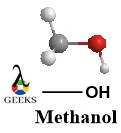Methanol is the first member of the hydroxyl group functionality in organic chemistry. Let us analyze facts related to it as illustrated in this article.
Methanol also known as the wood spirit is an aliphatic organic compound that is produced by the hydrogenation of carbon monoxide. It is a volatile, pungent odor colorless compound that has both academic and commercial importance.
Methanol has a crucial position in the chemical industry because it is an innovative replacement for completing the world’s energy needs. It has applications in the energy sector, in climatic improvement, and in household appliances as well. Let us discuss its properties like reactivity, magnetism, and periodic properties.
CH3OH IUPAC name
The IUPAC name of CH3OH is methanol. The other common and popular names of CH3OH are carbinol, hydroxymethane, and methyl hydroxide.
CH3OH chemical formula
The chemical formula of methanol is CH3OH or CH4O where C is the central atom surrounded by 3 hydrogen atoms and one hydroxyl OH group.

CH3OH CAS number
The CAS number of CH3OH is 67-56-1.
CH3OH ChemSpider ID
The ChemSpider ID of CH3OH is 864.
CH3OH chemical classification
The chemical properties associated with CH3OH are:
- CH3OH is a strong organic compound that is formed by the destructive distillation of wood.
- Methanol is a very strong hydroxy compound that can cause severe medical problems upon ingestion.
- CH3OH is used in many organic synthetic methodologies and is completely soluble in water.
- In the present scenario, CH3OH is used as a clean-burning fuel as a substitute for gasoline in automated vehicles.
CH3OH molar mass
The molar mass of CH3OH is 32.04 g/mol.
CH3OH color
CH3OH is a colorless liquid in its appearance.
CH3OH viscosity
The viscosity of CH3OH is 0.6906×10-6 m2/s at 298.2 K which is very low. Due to its lower viscosity than gasoline, it can easily atomize and mix with air.
CH3OH molar density
The molar density of CH3OH is 0.792 g/cm3.
CH3OH melting point
The melting point of CH3OH is -97.6 degree celsius which is very low. This implies that it has very low intermolecular forces.
CH3OH boiling point
The boiling point of methanol is 64.7-degree Celsius which is high because there is the presence of intermolecular hydrogen bonds.
CH3OH state at room temperature
CH3OH exists as a light and volatile liquid at room temperature.
CH3OH ionic/covalent bond
CH3OH exhibits covalent bonding because all the individual atoms are nonmetals. Here C is the central atom with 4 valence electrons which are shared by single covalent bonding with 3 H atoms and 1 OH atom.
CH3OH electron configurations
Electron configuration is the precise way of electron distribution according to azimuthal quantum number. Let us understand it in the case of CH3OH.
Empirically in CH3OH, there is 1 carbon atom, 4 hydrogen atoms, and 1 oxygen atom. The electronic configuration of C is [He]2s22p2, H is 1s1, and O is [He]2s22p4.
CH3OH oxidation state
The oxidation state of C in CH3OH is +2. In compounds, the oxidation state of the central atom is given significance instead of the terminal atoms.
CH3OH acidity/alkaline
Methanol is neither acidic nor basic, instead, it is an amphoteric compound according to the bronsted-lowry concept. It can be a proton donor as it can easily donate O-H protons to strong bases. Similarly, it can be a proton-acceptor because oxygen accepts protons from strong acids.
Is CH3OH odorless?
Methanol is not odorless. It has a sweet pungent odor like its ethyl counterpart.
Is CH3OH paramagnetic?
The magnetic character of any compound is influenced by the unpaired electrons present in it. Let us understand the bonding influence and magnetism in CH3OH.
CH3OH is not paramagnetic. Its magnetic ordering is diamagnetic as there are no unpaired electrons in it. Every atom is formed by the sharing of electrons thereby completing its octet.
CH3OH hydrates
CH3OH does not have hydrates. Instead, it is a hydrate inhibitor because of its chemical properties as it can lower the freezing point and is used as an antifreeze to separate the cleaning fluids.
CH3OH crystal structure
Solid methanol has crystal structure alpha, beta and gamma made up of infinite hydrogen bonds. On the other hand, liquid methanol exists in chain and ring crystal structures.
CH3OH polarity and conductivity
CH3OH is a polar molecule with a relative polarity of 0.762 and has high thermal and electrical conductivity because of its polar nature.
CH3OH reaction with acid
CH3OH being an amphoteric compound can easily react with both weak and strong acids. During reaction with acids, it acts as a base resulting in methyl compounds which are salt and neutral according to the neutralization reaction.
CH3OH + CH3COOH = CH3COOCH3 + H2O
2CH3OH + H2SO4 = CH3OCH3 + H3O+ + HSO4–
CH3OH + HCl = CH3OH2+ + Cl–
CH3OH reaction with base
The reaction of CH3OH with base is like a neutralization reaction where CH3OH is an acid because of its amphoteric nature. There is deprotonation of the hydroxyl group which turns it into an alkoxide anion.
CH3OH + NaOH = CH3ONa + H2O
CH3OH + NH3 = CH3O– + NH4+
CH3OH reaction with oxide
Oxidation of methanol or its reaction with any oxide results in the formation of aldehyde and hydrogen peroxide.
CH3OH + O2 = HCHO + H2O2
CH3OH reaction with metal
Methanol does react with metals and their alloys where it can vigorously attack metal sites forming thin films by adsorption.
Conclusion
In a nutshell, CH3OH is an important compound in organic chemistry that has characteristics and properties that can be put into application. Apart from that, it can undergo various medical, chemical, and biogeochemical reactions due to its versatile nature.

Hello, I am Mansi Sharma, I have completed my master’s in Chemistry. I personally believe that learning is more enthusiastic when learnt with creativity. I am a Subject Matter Expert in Chemistry.
Let’s connect through LinkedIn: https://www.linkedin.com/in/mansi-sharma22